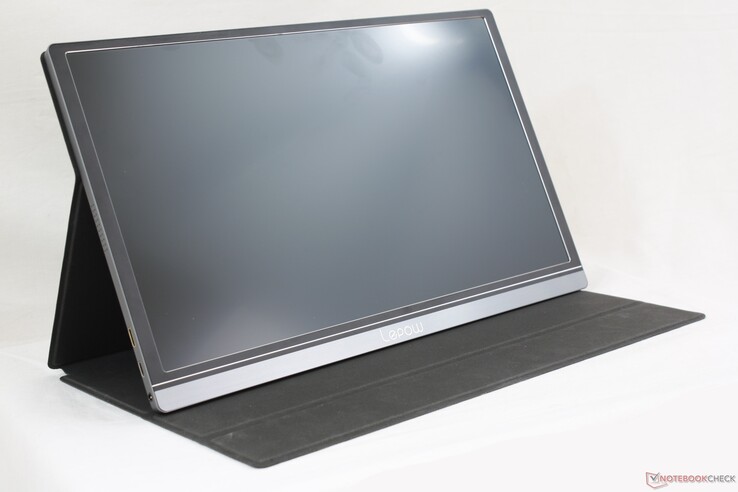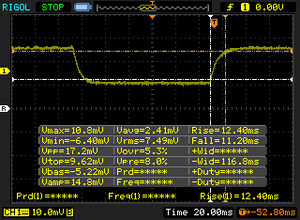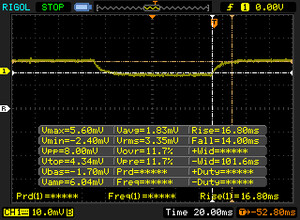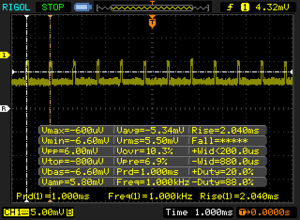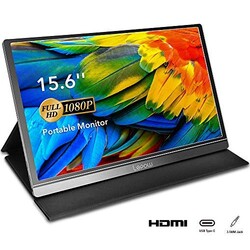Test: Lepow Portable Monitor - USB-driven portabel skärm
Topp 10...
» Topp 10: Bästa bärbara allround/multimediadatorerna
» Topp 10: Bästa bärbara speldatorerna
» Topp 10: Bärbara budget/kontorsdatorer
» Topp 10: Bästa bärbara kontors/premiumdatorerna
» Topp 10: Bärbara arbetsstationer
» Topp 10: De bästa små/kompakta bärbara datorerna
» Topp 10: Bästa ultrabooks
» Topp 10: Bästa hybriddatorerna
» Topp 10: Bästa surfplattorna
» Topp 10: Marknadens bästa smartphones
| |||||||||||||||||||||||||
Distribution av ljusstyrkan: 88 %
Kontrast: 259:1 (Svärta: 0.75 cd/m²)
ΔE ColorChecker Calman: 6.66 | ∀{0.5-29.43 Ø4.77}
calibrated: 3.83
ΔE Greyscale Calman: 7.6 | ∀{0.09-98 Ø5}
61.8% sRGB (Argyll 1.6.3 3D)
39.3% AdobeRGB 1998 (Argyll 1.6.3 3D)
42.71% AdobeRGB 1998 (Argyll 3D)
62.1% sRGB (Argyll 3D)
41.31% Display P3 (Argyll 3D)
Gamma: 2.04
CCT: 8567 K
| Lepow Type-C Portable Monitor X0025I0D4P 15.6", 1920x1080 | Odake BladeX 4K UHD 15.6", 3840x2160 | Dell XPS 15 2018 i5 FHD 97Wh Sharp SHP149A LQ156M1, LED IGZO IPS InfinityEdge, 15.6", 1920x1080 | Lenovo Ideapad 330S-15ARR-81FB00C7GE LG Philips LP156WFC-SPD1, IPS, 15.6", 1920x1080 | Asus VivoBook S15 S532F LG Philips LP156WFC-SPD1, IPS, 15.6", 1920x1080 | Apple MacBook Pro 15 2018 (2.6 GHz, 560X) APPA040, IPS, 15.4", 2880x1800 | |
|---|---|---|---|---|---|---|
| Display | 105% | 57% | -8% | -10% | 101% | |
| Display P3 Coverage (%) | 41.31 | 90.5 119% | 66 60% | 38.1 -8% | 37.12 -10% | 98.7 139% |
| sRGB Coverage (%) | 62.1 | 100 61% | 96.5 55% | 57.2 -8% | 55.9 -10% | 99.9 61% |
| AdobeRGB 1998 Coverage (%) | 42.71 | 100 134% | 66.7 56% | 39.4 -8% | 38.35 -10% | 86.6 103% |
| Response Times | -17% | -43% | -6% | 9% | -36% | |
| Response Time Grey 50% / Grey 80% * (ms) | 30.8 ? | 40 ? -30% | 49 ? -59% | 34 ? -10% | 24.8 ? 19% | 43.2 ? -40% |
| Response Time Black / White * (ms) | 23.6 ? | 24.4 ? -3% | 30 ? -27% | 24 ? -2% | 24 ? -2% | 31.2 ? -32% |
| PWM Frequency (Hz) | 1000 ? | 961 ? | 117000 ? | |||
| Screen | 77% | 98% | 44% | 26% | 130% | |
| Brightness middle (cd/m²) | 193.9 | 371.9 92% | 413 113% | 265 37% | 262.3 35% | 520 168% |
| Brightness (cd/m²) | 192 | 366 91% | 378 97% | 242 26% | 250 30% | 492 156% |
| Brightness Distribution (%) | 88 | 88 0% | 86 -2% | 74 -16% | 89 1% | 88 0% |
| Black Level * (cd/m²) | 0.75 | 0.31 59% | 0.29 61% | 0.215 71% | 0.43 43% | 0.39 48% |
| Contrast (:1) | 259 | 1200 363% | 1424 450% | 1233 376% | 610 136% | 1333 415% |
| Colorchecker dE 2000 * | 6.66 | 6.36 5% | 2.44 63% | 6.16 8% | 5.81 13% | 1.2 82% |
| Colorchecker dE 2000 max. * | 18.75 | 10.34 45% | 4.46 76% | 18 4% | 14.7 22% | 2.3 88% |
| Colorchecker dE 2000 calibrated * | 3.83 | 5.89 -54% | 2.48 35% | 6.18 -61% | 5.36 -40% | |
| Greyscale dE 2000 * | 7.6 | 3.7 51% | 2.48 67% | 3.79 50% | 2.8 63% | 1.3 83% |
| Gamma | 2.04 108% | 2.19 100% | 2.43 91% | 2.34 94% | 2.15 102% | 2.18 101% |
| CCT | 8567 76% | 6474 100% | 7006 93% | 7258 90% | 7016 93% | 6738 96% |
| Color Space (Percent of AdobeRGB 1998) (%) | 39.3 | 91.7 133% | 62 58% | 36 -8% | 35.2 -10% | |
| Color Space (Percent of sRGB) (%) | 61.8 | 100 62% | 96 55% | 57 -8% | 55.6 -10% | |
| Totalt genomsnitt (program/inställningar) | 55% /
71% | 37% /
72% | 10% /
28% | 8% /
17% | 65% /
98% |
* ... mindre är bättre
Visa svarstider
| ↔ Svarstid svart till vitt | ||
|---|---|---|
| 23.6 ms ... stiga ↗ och falla ↘ kombinerat | ↗ 12.4 ms stiga | |
| ↘ 11.2 ms hösten | ||
| Skärmen visar bra svarsfrekvens i våra tester, men kan vara för långsam för konkurrenskraftiga spelare. I jämförelse sträcker sig alla testade enheter från 0.1 (minst) till 240 (maximalt) ms. » 53 % av alla enheter är bättre. Detta innebär att den uppmätta svarstiden är sämre än genomsnittet av alla testade enheter (20.2 ms). | ||
| ↔ Svarstid 50 % grått till 80 % grått | ||
| 30.8 ms ... stiga ↗ och falla ↘ kombinerat | ↗ 16.8 ms stiga | |
| ↘ 14 ms hösten | ||
| Skärmen visar långsamma svarsfrekvenser i våra tester och kommer att vara otillfredsställande för spelare. I jämförelse sträcker sig alla testade enheter från 0.165 (minst) till 636 (maximalt) ms. » 40 % av alla enheter är bättre. Det betyder att den uppmätta svarstiden liknar genomsnittet av alla testade enheter (31.6 ms). | ||
Skärmflimmer / PWM (Puls-Width Modulation)
| Skärmflimmer / PWM upptäckt | 1000 Hz | ≤ 23 % ljusstyrka inställning | |
Displayens bakgrundsbelysning flimrar vid 1000 Hz (i värsta fall, t.ex. med PWM) Flimrande upptäckt vid en ljusstyrkeinställning på 23 % och lägre. Det ska inte finnas något flimmer eller PWM över denna ljusstyrkeinställning. Frekvensen för 1000 Hz är ganska hög, så de flesta användare som är känsliga för PWM bör inte märka något flimmer. Som jämförelse: 53 % av alla testade enheter använder inte PWM för att dämpa skärmen. Om PWM upptäcktes mättes ett medelvärde av 8091 (minst: 5 - maximum: 343500) Hz. | |||
(+) Den maximala temperaturen på ovansidan är 39 °C / 102 F, jämfört med genomsnittet av 36.9 °C / 98 F , allt från 21.1 till 71 °C för klassen Multimedia.
(+) Botten värms upp till maximalt 39.4 °C / 103 F, jämfört med genomsnittet av 39.2 °C / 103 F
(±) Handledsstöden och pekplattan kan bli väldigt varma vid beröring med maximalt 39 °C / 102.2 F.
(-) Medeltemperaturen för handledsstödsområdet på liknande enheter var 28.7 °C / 83.7 F (-10.3 °C / -18.5 F).
Apple MacBook 12 (Early 2016) 1.1 GHz ljudanalys
(+) | högtalare kan spela relativt högt (83.6 dB)
Bas 100 - 315 Hz
(±) | reducerad bas - i genomsnitt 11.3% lägre än medianen
(±) | linjäriteten för basen är genomsnittlig (14.2% delta till föregående frekvens)
Mellan 400 - 2000 Hz
(+) | balanserad mellan - endast 2.4% från medianen
(+) | mids är linjära (5.5% delta till föregående frekvens)
Högsta 2 - 16 kHz
(+) | balanserade toppar - endast 2% från medianen
(+) | toppar är linjära (4.5% delta till föregående frekvens)
Totalt 100 - 16 000 Hz
(+) | det totala ljudet är linjärt (10.2% skillnad mot median)
Jämfört med samma klass
» 7% av alla testade enheter i den här klassen var bättre, 2% liknande, 91% sämre
» Den bästa hade ett delta på 5%, genomsnittet var 18%, sämst var 53%
Jämfört med alla testade enheter
» 4% av alla testade enheter var bättre, 1% liknande, 94% sämre
» Den bästa hade ett delta på 4%, genomsnittet var 24%, sämst var 134%
För
Emot
Läs den fullständiga versionen av den här recensionen på engelska här.
Den portabla Lepow-skärmen har utmärkt konstruktionskvalitet, särskilt med tanke på det låga instegspriset. Den är lätt och tillräckligt liten för att kunna bäras runt tillsammans med en laptop, precis som en vanlig surfplatta. Skärmen är bra nog för surfande, datainmatning och visst spelande även om vi tycker att lite mer ljusstyrka och kontrast hade gjort upplevelsen mycket bättre.
Det som är opraktiskt är att den kräver två olika kablar för att kunna användas. Även om alla kablar som behövs ingår i förpackningen är det ändå krångligt att behöva bära runt på en USB Typ C till Typ A-kabel och en mini HDMI-kabel. Skärmen behöver kontinuerligt dra ström från din laptop vilket förstås kommer påverka batteritiden på din PC eller MacBook. En Thunderbolt 3-port eller ett inbyggt batteri hade minskat röran genom att ta bort behovet av två kablar, så som på Odakes 4K-monitor.




